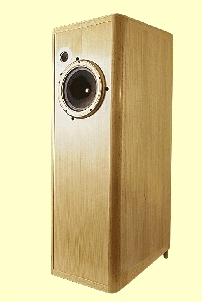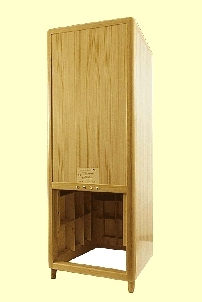  | General overview: Speakers in a league of their own...Yet with a classical appearance, beautifully finished woodwork and conventional drive unit positioning—except for the tweeters, which are placed asymmetrically above and to the left of the bass/midrange units and, rather curiously, are in the same position on both cabinets. The designer’s explanation: “The search for a true point source led to this particular configuration, which remains valid for both the left and right speakers”. The bass/midrange driver has an imposing gold-coloured bronze surround that serves as a plate for fixing it to the front baffle, which is made of 30 mm beech strengthened by two vertical braces of 50 mm spruce. The piezoelectric tweeter with paper membrane also features a small gold-coloured surround. Nothing particularly out of the ordinary so far, until you notice that the cabinets have no floor. The side walls sit on a wedge-shaped base that is several centimetres higher at the back than the front. Two feet at the rear corners lift the cabinet back towards the upright position, leaving the front baffle titled just a few degrees back from the vertical. More surprising yet, as you can see in the second photo, the back panel stops around 40 cm short of the cross brace between the rear feet. And that’s not all: as photo shows, the cabinet is entirely empty. The complete absence of any damping material marks a radical break with the accepted approach to acoustic cabinet design over the last 50 years or so... The side and back panels are of spruce, crossed and glued under pressure, and are just 2.5 millimetres thick. But where Ocellia really excels is in its complete mastery of the internal bracing, which provides perfect rigidity for the cabinets, in which no two internal surfaces are parallel to each other. The internal cables are made of pure silver with paper insulation. The bass/midrange unit voice coil is silk-insulated. The manufacturer claims a sensitivity of some 98 dB. So what do they sound like? In a word: breathtaking. Your ears search in vain for acoustic references by which to analyze the sound. But all you can hear is music. Pure musicality. The timbres are so natural it’s difficult to find anything to comment on. No possible confusion between, say, a pianoforte and a modern piano. In fact, a piano specialist listening to the Celia Silvers would no doubt be able to tell you not just the make of the piano, but probably the year it was made as well. And if it was a Steinway, whether it was made in Hamburg or New York. The “grain” of the strings is such that you’d be forgiven for believing you could work out exactly how much rosin the violinist had put on his or her bow to get just that right level of vibrato. For a hi-fi critic, it was a real job to continue any kind of objective analysis and not just give in and be seduced by the Celia’s irresistible allure. I tried to put my finger on exactly what sets them apart and to account for their performance in rational, objective terms. And after many hours of listening, I think I found it: their incredible ability to reproduce micromodulations, i.e. the tiny differences in sound level, the slightest impulses, the musician’s subtlest intentions. For: Without a shadow of a doubt: a state-of-the-art speaker. You’ve only got to listen to the Celia Silvers once and you’ll want to spend the rest of your life with them, just appreciating music. Against: Not surprisingly, the price. But don’t forget that the Celias only need a few watts of power, though they like the right kind of watts. RRP (France): 7,900 euros Overall sound: 8.9 Value for money and ease of installation: 6.5 Purchase cost: 7.7 Conclusion Speakers in a league of their own that thoroughly deserve our overall rating of three exclamation marks !!! |